Like art itself, model railroading comes in many forms and the choices involved can be overwhelming. How do you know what direction to go in? In this post I want to explore ways of discovering your own visual design language.
Overarching Themes
Many of us had early exposure to the railroad and formed strong memories and images that influenced our modeling. Others may draw inspiration from books or magazines. In time a preference for one type of railroading often develops. In the art world this type of overarching preference may become a strong foundation that informs the work over a lifetime.
I’m drawn to images of single track, short trains and slow, simple operations. My first hand experiences of the yard engine from Richmond working the siding in Centerville embodied all of these qualities and cemented them in my imagination. Even though I saw plenty of mainline freights and passenger runs, they were here and gone in an instant. The local was a slower, up close and personal experience in a way that watching mainline traffic roar through town wasn’t. Looking back now, I can clearly see the through line of this theme in my modeling. The relaxed operation of a short train running on decrepit track is a constant, whether I’m freelancing or closely following a prototype. If I had to sum it up in one word, the local was approachable. While I tried many times to embrace the idea of mainline running, it never brought the sense of satisfaction I wanted.
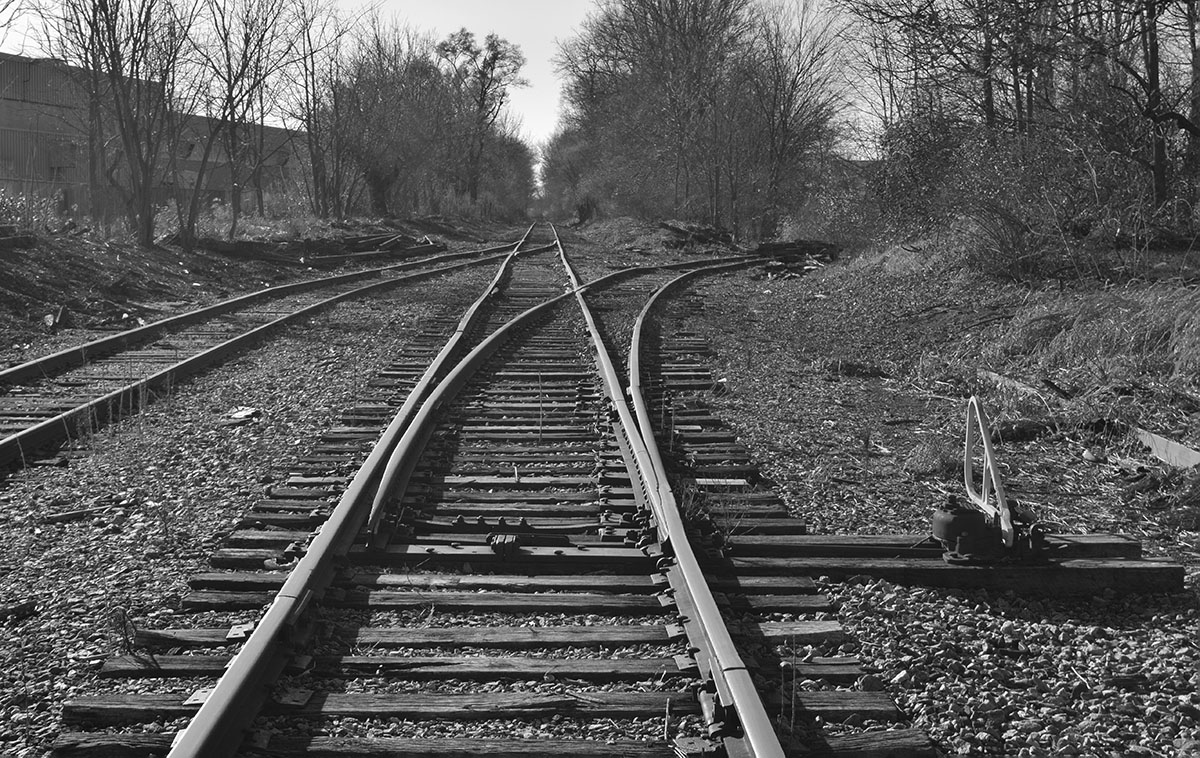
.Images of the railroad like this one were cemented in my imagination at an early age and formed a continuous through line for my modeling.
A Strong Bias For Close-ups
I was and still am nearsighted and have to get close to an object to see it clearly without glasses. This viewpoint exerts a strong influence on how I see the world and of all the factors that inform my modeling this one has the strongest influence. Observing the railroad up close brought an emphasis on details, texture and later, all the subtle variations in color to my attention.
Understanding how I saw the railroad proved to be a turning point in my own journey. I know why I prefer certain images and operation to others. I’m expressing what’s meaningful to me in ways that are also meaningful. I no longer feel any need or conflict to follow what’s trendy or popular.
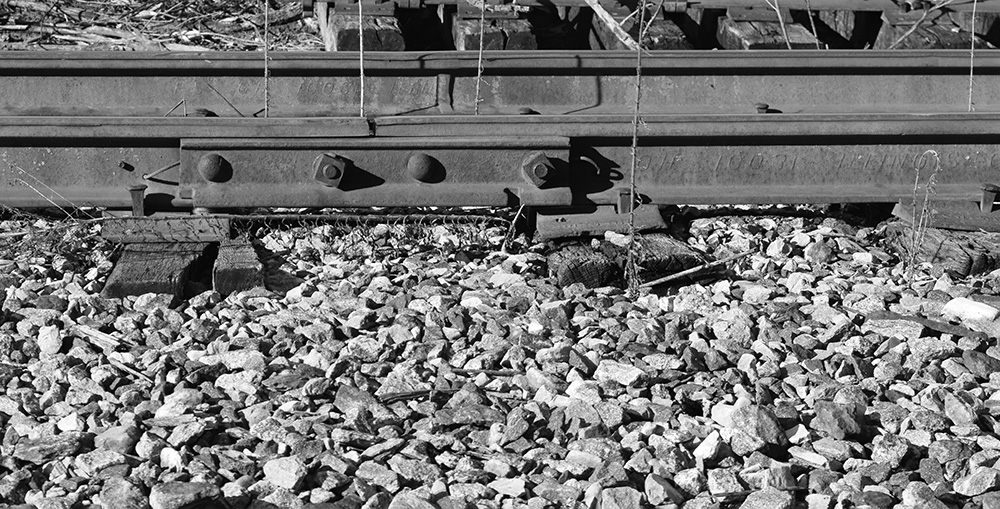
Being nearsighted produced a strong bias for getting up close in order to see things clearly.
How Do You See The Railroad?
Your experiences and influences will be different from mine yet similar in their impact. You may prefer the thrill of mainline traffic however brief the experience is. Your access to the railroad may be far more restricted than mine was and that too will fuel your imagination. Think about your own designs. Are you simply doing what everyone else does or have you considered how your own influences can inform the work on a deeper level?
Visual Design:
A Strong Bias For Smaller Scenes
Coupled with the close-up viewpoint, I realized I strongly prefer a certain size of layout regardless of the potential a larger one may offer. At the time most of my layouts were two feet wide because it was the most economical way to use the lumber, and was the default choice promoted in the magazines. Invariably though, the excess depth was seldom used as once I got a few inches away from any track, I lost all interest in the scenery.
The ongoing frustration of this experience led me to try a narrower depth of sixteen inches where, in HO, there is still plenty of room for multiple tracks and structures, if that’s what you want. As silly it may sound making this decision felt like a weight off my shoulders and at the time, generated a sense of freedom unlike anything I’d experienced in a long time.
Paradoxically, you would think that quarter-inch scale would need the additional depth. Depending on what a scene requires, it certainly can but for the type of scenes I most enjoy, the constraint of this shallow depth strongly enhances the close-up focus on the track and trains by eliminating the distractions from nonessential elements that are simply there to fill empty space.
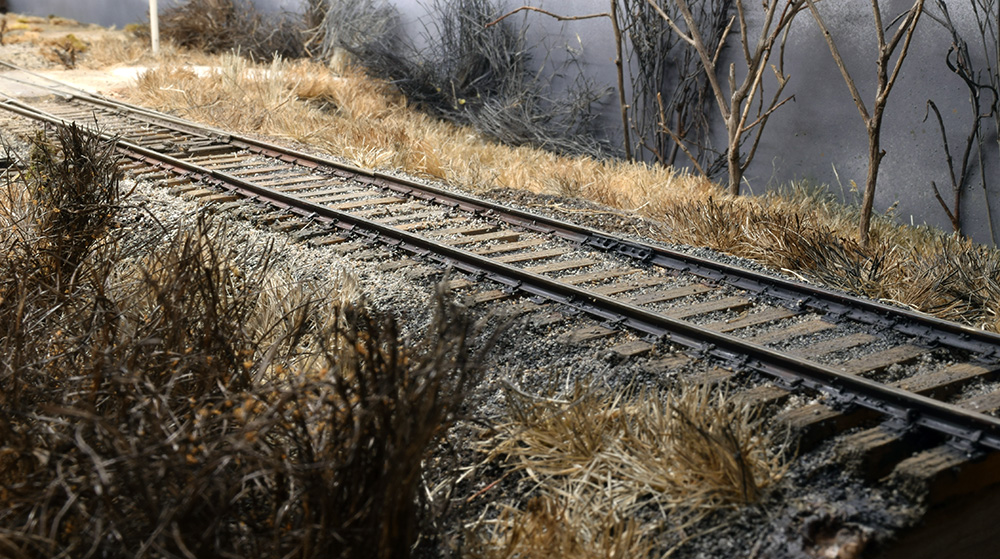
A shallow depth may seem counterintuitive with a large scale but it focuses the eye on what’s important and eliminates the distraction of excess clutter that’s only there to fill empty space.
The Influence Of The Landscape
My views of the landscape changed when I discovered the work of Andrew Wyeth. His stark and often spare compositions taught me to see in a different way. During my twenties, I often went for long walks to nearby woodlands just to spend time alone and to be in nature. I didn’t know it then but now I realize how those images of trees and the woods seeped into my mind and formed a basis for expressing the landscape, where again, several design themes began to show up in my work.
Looking Through And Beyond
I like images where you look through a stand of trees to something beyond. I like the contrast of near and far, open and closed, along with the rhythmic pattern of the tree trunks across the picture plane. Related to this is a view where the center of interest is framed by one or more large objects such as a tree or corner of a building. A strong leading line is often part of such compositions.
Both Strong And Subtle Contrasts
I like the strong contrast between light and dark, large and small, rough and smooth. As a change of pace the subtle light and tight values of fog also hold a strong attraction.
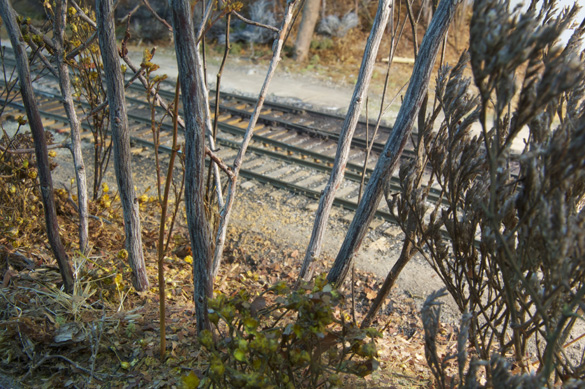
(Above) The idea of looking through and beyond is a perspective I enjoy. In the image below, a framed view with strong leading lines like this curved siding, also show up frequently in my photography and paintings as does a strong contrast between light and shadow (seond image below). At the opposite extreme I also enjoy the subtle values and mystery of a fog shrouded scene.
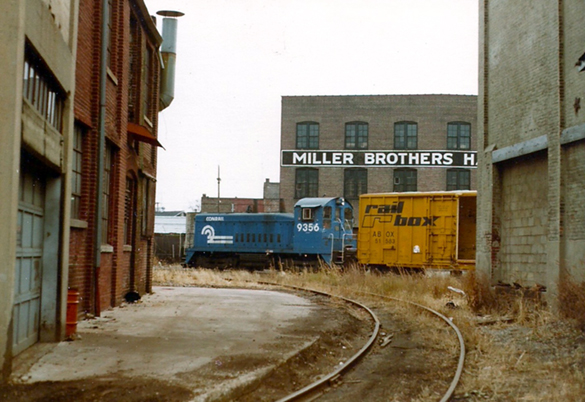
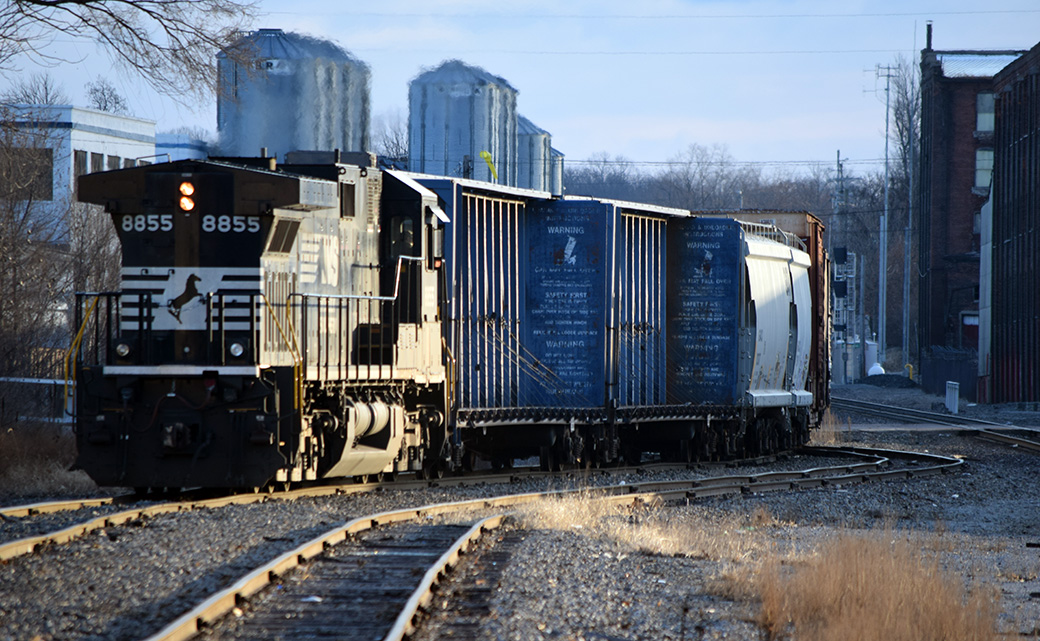
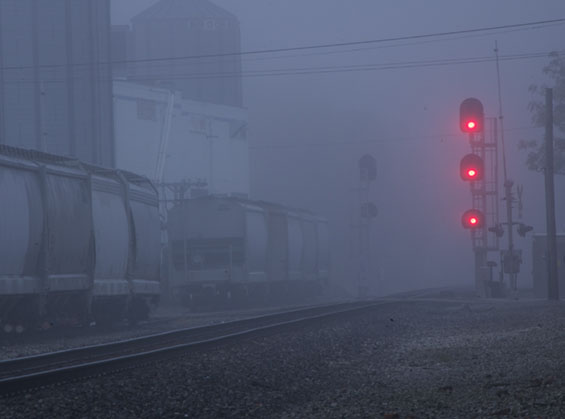
Awareness Leads To Growth
How do these factors impact the modeling? To begin, I’m more aware of what I’m trying to achieve in the work. Mill Road is a personal expression of my early memories of the railroad, where I bring a far different set of criteria from normal modeling practice. With Mill Road, my focus is tighter and centered on the qualities of the railroad I remember and enjoy.
Going forward, I want to bring all of my understanding, experience and creative knowledge to the work rather than see model railroading as a separate thing governed by its own rules and conventions. I now see modeling as another medium for creative expression, instead of a slavish reinterpretation of an increasingly remote and overdone era of the past.
I believe that better modeling begins with the modeler’s understanding, awareness and intent. In closing I suggest that each of you have a design aesthetic formed by images of the railroad and other visual clues that you may or may not be fully aware of. Rather than offer up yet another dry formula full of empty promises, I encourage you to reflect on a couple of questions:
What does the railroad mean to you personally?
What do you want from this craft? (Not what the mainstream says, but what you actually want?)
Think of photography, art and other visual mediums. What types of images are you drawn to again and again? What qualities do they share?
I firmly believe that the only answers that matter for your situation are the ones you and you alone provide for these questions.
Regards,
Mike
I love these questions. May I try? Using them as a framework:
What does the railroad mean to you personally?
Like you the railroad has been a friend I visit. My childhood friend was the railroad in Charlottetown and today’s it’s the railroad here in Halifax. We hang out together and we are aging at the same time; we change together. In the silent moments between spoken ideas we discover things about each other. Because you asked the question I thought how this is a disconnect in how we advise in model railroading. In the traditional advice, we ask the modeller to identify an inspirational prototype and then adopt that as our guide, informing all subsequent decisions, but that’s not like our relationship with the real railroad. We didn’t chose the real railroad or any part of how it is. We attend it as it is; as it is when we see it in that moment. Would our model railroad be different if we did that instead? I don’t have an answer but wonder how our relationship with the real railroad would only be made less valuable if we approached it the same way we do the hobby? If we only spent time with real railroads that comply to our narrative? Fit our particular view of it? Instead of wondering how we could coexist.
What do you want from this craft? (Not what the mainstream says, but what you actually want?)
We tend to answer this question in terms of craft (“I learned woodworking from making benchwork”) and I do this too: Because of model railroading I have a place to practice things like applying my training and drafting tools toward Prince Street’s previous 3D printing products. It’s also a canvas (literally) to paint because I enjoy doing that but don’t make time for actual oil or watercolour painting so my model railroad is providing me a place to indulge in the feeling of moving paint around and observing how it changes my sense of place.
Any kind of sculptural work would be as fun to experiment with as means of recording imagination but I also really like trains so model railroading is still that happy medium at the intersection of representing an emotional response in a tactile form. I think I was failing to understand that relationship. I kept adhering to a hierarchy that looked for a contented relationship based on a prototype railroad. As if my identity was wholly defined by an external terminology like “what it is to be a man” but instead “how I got happy modelling the CNR in PEI”. So, I’m experimenting with identity and think that by rearranging how I look for work to be informed by real railroading, and to be like railroading, but guided by more personal priorities such as material choices or, if nothing else, fit more practically in terms of what I’m willing to invest back into my work.
Think of photography, art and other visual mediums. What types of images are you drawn to again and again? What qualities do they share?
This was a big point of contention that I was failing to understand in my previous approach. I would look to painters or photographers whose work I admire and study and be frustrated at how I couldn’t express myself the same way. I’d look at their work and know we held an equally powerful connection to our inspiration but I wasn’t understanding that what distinguished their work from mine was that they had practiced their craft aligned to communicating how they saw what they saw and how they ignored most other things that did not support that vision. I expected to have to start over from scratch but I’m trying to learn to do things that are expressed in my voice and this has changed my relationship with the hobby. I don’t expect it will result in better models (using the traditional model railroading rubric) but I think I’ll have a richer understanding of what I’ve made and how it fits against my vision and that feels like a more honest experience. I had to realise that those artists I admired were trying to paint what it felt like to look at that thing that inspired them not paint that thing. “Paint that thing” is too literal.
Those are good questions. My thoughts above are ones I’m still working on and I enjoy imagining how my responses will evolve over time. I’m thrilled that there is time where I didn’t see it before.
Hi Chris,
I’m always humbled that people take time to engage with this blog. I’m even more humbled by the consistent depth and thoughtfulness of your comments. You took the questions farther than I ever imagined and sparked a conversation that takes the craft into new territory. Thank you.
The idea of accepting the railroad as we find it is brilliant. (Edit) We do this because we didn’t have a hand in creating this location. the terrain is here, the track is in place, alterations have occurred over time. We’re simply observers of what is. In modeling, we create the vision then bring it into existence. What if we accepted available space for a layout in a similar manner as we do the railroad in a place, and designed accordingly? Where space determines the form of the layout much as a location and geography shape the railroad. You and I, along with the others who look beneath the surface of things, can articulate why a form is more pleasing to us than another, without resulting to a canned solution that simply relieves the tension of an unresolved problem.
Mike